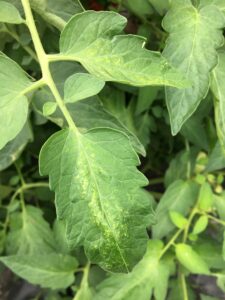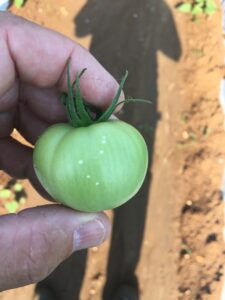Sweet Corn
Low numbers of European corn borer (ECB) moths continue to be captured in a few of the remaining blacklight traps in the northern and central counties, although feeding in whorl and pre-tassel stage corn is low and sporadic in occurrence. The highest feeding levels are in southern Hunterdon County. ECB injury over 12% of plants infested has been found in that area recently. While ECB has become something of a local phenomenon in NJ, growers should not assume that feeding is below economic levels in their area. It is typical for feeding percentages to rise as the moth catch declines. We expect feeding to increase for the next 1-2 weeks before peaking.
 Look for the characteristic “shot-hole” type of feeding (photo below at right) and consider treating when infested plants exceed 12% in a 50 plant sample. As plantings proceed to the pre-tassel stage, ECB larvae may be found in emerging tassels (see photo at left). It is a good idea to treat individual plantings as they move into the full tassel/first silk stage one time. This eliminates any ECB larvae that have emerged with the tassels as they begin to move down the stalk to re-enter near developing ears.
Look for the characteristic “shot-hole” type of feeding (photo below at right) and consider treating when infested plants exceed 12% in a 50 plant sample. As plantings proceed to the pre-tassel stage, ECB larvae may be found in emerging tassels (see photo at left). It is a good idea to treat individual plantings as they move into the full tassel/first silk stage one time. This eliminates any ECB larvae that have emerged with the tassels as they begin to move down the stalk to re-enter near developing ears.
Useful insecticides for this particular application include synthetic  pyrethroids (IRAC Grp 3), spinosyns (including OMRI approved Entrust) IRAC Grp 5), and diamides such as Coragen or Vantacor (IRAC Grp 28) or materials such as Besiege which include the active ingredient in Coragen. Synthetic pyrethroids alone should NOT be used for corn earworm (CEW) protection on silking corn. Control with these materials is very inconsistent.
pyrethroids (IRAC Grp 3), spinosyns (including OMRI approved Entrust) IRAC Grp 5), and diamides such as Coragen or Vantacor (IRAC Grp 28) or materials such as Besiege which include the active ingredient in Coragen. Synthetic pyrethroids alone should NOT be used for corn earworm (CEW) protection on silking corn. Control with these materials is very inconsistent.
The highest nightly trap catches of ECB for the week ending 6/14/23 are as follows:
| Allamuchy 1 | Hillsborough 1 | Sergeantsville 1 |
| Bellemeade 1 | Pennington 1 | South Branch 1 |
| Clinton 1 | Port Murray 1 | |
| Farmingdale 1 | Princeton 1 |
Corn earworm (CEW) moths captures from northern and central blacklight traps have been scattered, with generally low numbers. Pheromone trap information is available from all northern and central sites, but remains limited from southern New Jersey. At present, pheromone trap captures from Cumberland and Salem counties (1 trap from each county) were fairly high for early June, while northern and central county pheromone traps indicate a persistent low population of moths. We will use a combination of pheromone and blacklight trap types to derive silk spray schedules by region. Until more pheromone traps are reporting consistently from the southern counties, no map can be produced. Silking corn is at risk of CEW infestation at this time. Be sure to access information from this publication in the upcoming weeks to determine how frequently you should treat silking sweet corn to protect it from CEW infestation.
The highest nightly blacklight trap catches of CEW for the week ending 6/14/23 are as follows:
| Matawan 3 | Denville 1 |
| Bellemeade 2 | Port Murray 1 |
| Asbury (Hunterdon) 1 | Sergeantsville 1 |
The highest nightly pheromone trap catches of CEW for the week ending 6/14/23 are as follows:
| East Vineland 38 | Califon 4 | Farmingdale 2 |
| Woodstown 21 | Georgetown 3 | Matawan 2 |
| Dayton 6 | South Branch 3 | Pennington 2 |
| Allamuchy 4 | Berlin 2 | Snyder Farm (Hunterdon) 2 |
Silking Spray Schedules*:
South – 3-4 days
Central – 4 days
North – 4-5 days
*These recommendations are based on regional catches. Adhere to tighter spray schedules if indicated by local trap catches. Synthetic pyrethroids alone should NOT be used for corn earworm (CEW) protection on silking corn, or for fall armyworm (FAW) management at any stage. Control with these materials is very inconsistent.
Peppers
The Rutgers Vegetable IPM Program has a limited number of peppper weevil (PW) trap kits that can be made available to commercial growers in the counties of: Atlantic, Camden, Cumberland and Salem. These kits include lures, sticky cards and mounting equipment. Growers will deploy and check their own traps. Please, commercial growers only. If interested, contact Joseph Ingerson-Mahar via email: Mahar@sebs.rutgers.edu or phone/text: 856-889-5718.
Tomatoes
 Bacterial leaf spot (BLS) symptoms have been absent from scouted fields from Burlington county northward. Prolonged dry weather has likely limited development of disease on farms with persistent bacterial issues. With more rain events in the forecast, growers should be on the lookout for BLS and bacterial canker. Symptoms of BLS infection include small, very dark lesions appearing on foliage of any age (see photo at left). Often even immature, unexpanded leaves are affected. Copper resistance in BLS populations in NJ has been identified. Bacterial canker is first characterized by marginal lesions on older foliage (photo below at left). These lesions work inward, ultimately killing entire leaves. Fruit lesions, also called bird’s eye spot (photo below at center) are initiated on very small fruit but become apparent as fruit enlarge. Dry lesions also may form on petioles (photo below at right). It is advisable that growers avoid working in fields when foliage is wet, to avoid easy spread of infections. Growers should also work from youngest blocks to oldest, to limit the chance of spreading disease to younger plants. Pruning, tying and harvesting are all ways that these diseases are dispersed throughout plantings. Bacterial infections in the field may be mitigated to some degree with systemic immune response activator Actigard, although results are often limited if weather and human activity favor spread. See the Tomato Section of the 2022/23 Commercial Vegetable Production Recommendations for further information.
Bacterial leaf spot (BLS) symptoms have been absent from scouted fields from Burlington county northward. Prolonged dry weather has likely limited development of disease on farms with persistent bacterial issues. With more rain events in the forecast, growers should be on the lookout for BLS and bacterial canker. Symptoms of BLS infection include small, very dark lesions appearing on foliage of any age (see photo at left). Often even immature, unexpanded leaves are affected. Copper resistance in BLS populations in NJ has been identified. Bacterial canker is first characterized by marginal lesions on older foliage (photo below at left). These lesions work inward, ultimately killing entire leaves. Fruit lesions, also called bird’s eye spot (photo below at center) are initiated on very small fruit but become apparent as fruit enlarge. Dry lesions also may form on petioles (photo below at right). It is advisable that growers avoid working in fields when foliage is wet, to avoid easy spread of infections. Growers should also work from youngest blocks to oldest, to limit the chance of spreading disease to younger plants. Pruning, tying and harvesting are all ways that these diseases are dispersed throughout plantings. Bacterial infections in the field may be mitigated to some degree with systemic immune response activator Actigard, although results are often limited if weather and human activity favor spread. See the Tomato Section of the 2022/23 Commercial Vegetable Production Recommendations for further information.
Two-spotted spider mites (TSSM) are being found in a few tomato high tunnels at this time. This is fairly common in the dry conditions inside the tunnels. Initial, low-level infestations result in a mite “stipple” on the upper leaf surface (see photo at right). In these cases several mites may be found on the lower leaf surface. With hot, dry conditions and no control applied, mites multiply rapidly. A large population will create webbing that can cover entire plant leaves and branches (see photo below). Large populations can become quite difficult to manage, so treatment should be applied upon finding a mite infestation at any level. This can limit future problems with this pest. There are a number of effective miticides listed in the Tomato Section from the 2022-23 Guide.
population will create webbing that can cover entire plant leaves and branches (see photo below). Large populations can become quite difficult to manage, so treatment should be applied upon finding a mite infestation at any level. This can limit future problems with this pest. There are a number of effective miticides listed in the Tomato Section from the 2022-23 Guide.
Cucurbit Downy Mildew
Cucurbit downy mildew has been detected on cucumbers in Atlantic County this week (see Dr. Wyenandt’s cucurbit downy mildew alert of 6/13/23. All cucumber and cantaloupe plantings should be protected at this time. Useful materials for CDM may be found in the Cucumber Section of the 2022/23 Commercial Vegetable Production Recommendations. A sentinel plot is now established at Snyder Farm in Hunterdon County. This plot, consisting of pumpkin, watermelon, cantaloupe, butternut, acorn, cucumber and kabocha squash will be used to indicate the presence of cucurbit downy mildew in the region, and what crops are affected. For regional information on this important disease, see the Cucurbit Downy Mildew webpage: http://cdm.ipmpipe.org/. Note that the forecast component of this site is not active this season. However, reports of CDM can still be reported on the site, and will appear on the homepage map down to county level, with associated host information.





